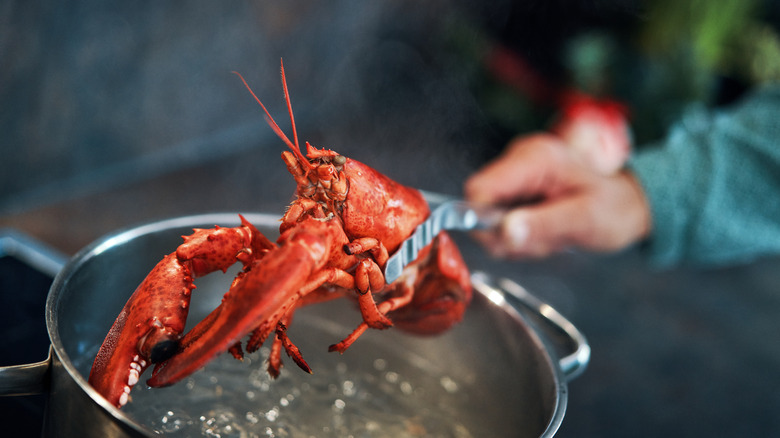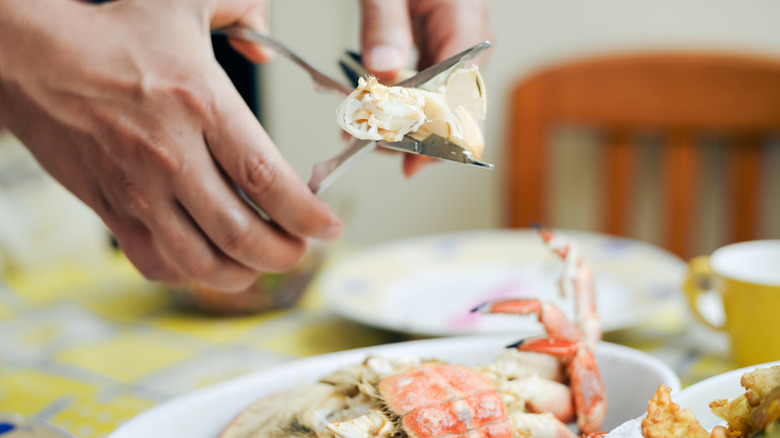Martha Stewart's Rule For Cooking Lobster
If you want to really indulge in seafood, lobster is the obvious way to go. Whether enjoying it plain with butter, in the form of a lobster roll, or made into lobster Newburg, any meal centering on lobster is easily considered a treat. You'll find lobster at practically any seafood restaurant, but making it at home can often be a better option, especially if you want to try a specific recipe or take advantage of a lobster-tail sale at your local grocery store.
As even inexperienced chefs know, cooking lobster involves either steaming or boiling it in hot water. This may seem simple, but there's quite a bit that can go wrong, including over-seasoning the water. Adding more than 2 or 3 tablespoons of salt per gallon can yield salty results and overpower the naturally sweet lobster flavor. With Martha Stewart's method, however, this issue shouldn't be a problem.
The celebrity chef advocates adding alcohol to the cooking pot, explaining in a Facebook Live post that she uses a combination of water and either vodka or tequila. Alcohol may seem like a strange addition, but it's no different than adding vodka to pasta sauce. When alcohol evaporates out, it leaves behind a more robust flavor, requiring little effort on your part. For lobster in particular, it adds another layer of sweet and salty flavor to the meat, and that means you won't have to add as much seasoning to the pot.
Alcohol seasoning isn't Martha Stewart's only lobster tip
After Martha Stewart shares her tip for seasoning lobster in a hot bath of vodka or tequila, she validates it by joking, "If you were going to be boiled alive, wouldn't you like to have a drink first?" Good point. But incorrect seasoning isn't the only boiled-lobster dilemma she addresses.
Over-seasoning is of little issue if your lobster is too dry to enjoy anyway. When using the boiling method, timing and temperature are everything. "If it's a pound and a quarter fresh from the sea, that's about 13 minutes, up to 18 minutes of cooking," Martha Stewart shared with Food & Wine. "Over 18 minutes, it's overcooked." If a lobster reaches more than 140 degrees Fahrenheit on the inside, you'll have tough and rubbery meat.
Just be aware that cooking times can vary when preparing a lobster, depending on things like how many lobsters are in the pot at one time. For more predictable and even results, it's best to avoid overcrowding the pot. That's easier to accomplish with smaller lobsters, which have potential advantages over larger ones. A smaller lobster will typically cook more evenly, requiring less time in the water and reducing the chance of overcooking. Some lobster lovers feel that small lobsters also have sweeter, more tender meat, especially when buying only the tail.
More tips on overcooking a lobster
Fresh lobster is no small investment, so you want to get things right before the grand feast. Fortunately, there are ways to know straight off if your lobster is overcooked. According to Martha, there's a telltale shrinkage that occurs. You won't know until you crack the lobster open and look inside the shell; but if the claw meat appears to be about 50% smaller than its shell, get ready for some rubbery lobster.
To avoid this, become familiar with the correct cooking times based on the lobster you've purchased. For example, while boiling the average-sized fresh, uncooked lobster can take up to 13 or 18 minutes, many people buy precooked lobsters from grocery seafood sections or through direct online seafood suppliers. This means you're just reheating cooked lobster, so it requires much less time in boiling water, generally up to two minutes. If the lobster is frozen, it's best to avoid uneven cooking by slowly thawing it first. You could otherwise have some portions undercooked and others overcooked.
Steaming a lobster requires roughly the same amount of time as boiling. But soft-shell lobsters can quickly overcook, so remove them about three minutes earlier than their hard-shelled counterparts. And don't forget to drain out excess water after cooking. This prevents the unappetizing spectacle of water seeping onto dinner plates but also stops further overcooking from hot-water remnants hiding within the shells. Just snip an opening in each claw before hanging to drain.


